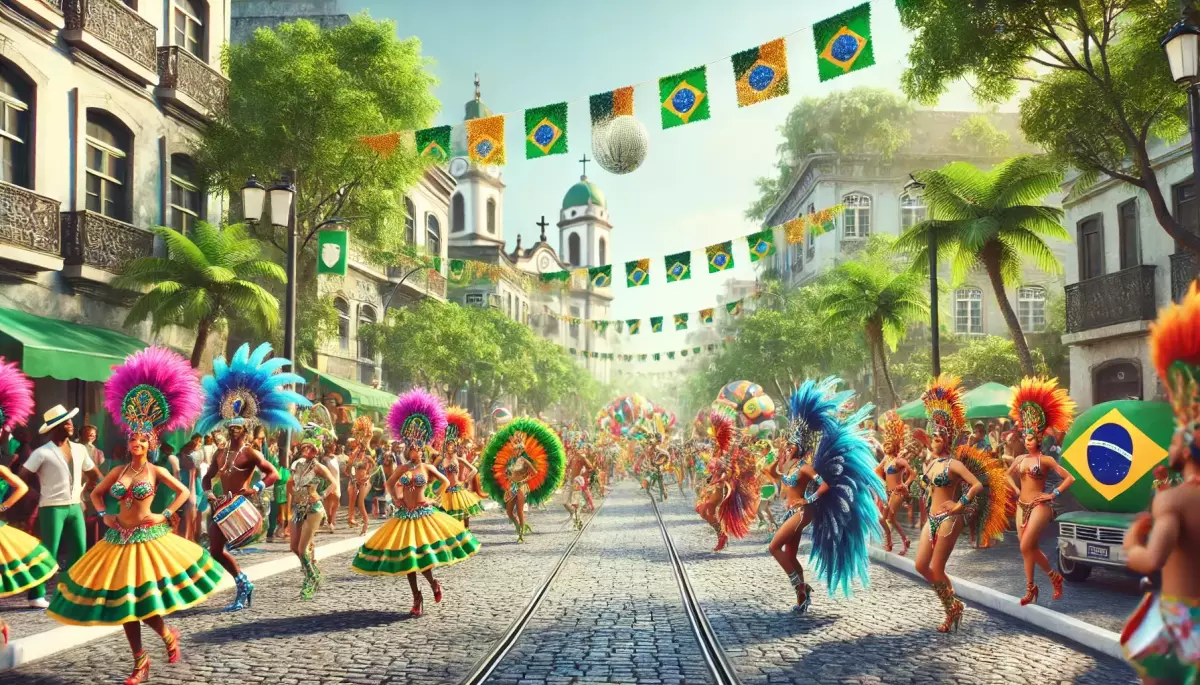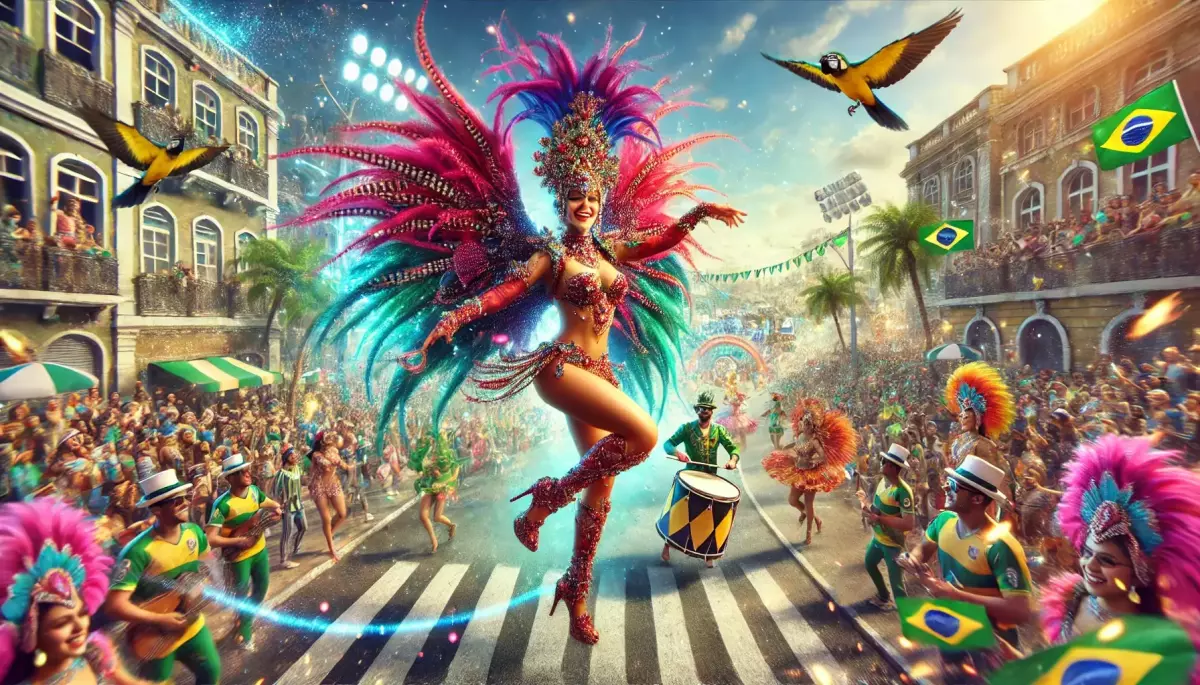Carnival is one of the most emblematic and vibrant festivals in Brazil, attracting millions of people from all over the world. This celebration, which takes place annually, is marked by exuberant parades, colorful costumes, and an atmosphere of pure joy. Each city has its own way of celebrating, but the festive spirit and the unity among revelers remain constant, creating a unique and contagious atmosphere.
During Carnival, the streets transform into stages for dance and music, where rhythms like samba, frevo, and axé echo in every corner. Moreover, it is an unparalleled opportunity to discover Brazilian culture and its traditions. Participation in the festivities is accessible to everyone, regardless of age or background, making everyone feel part of something greater.
So, if you haven't had the chance to experience this magical festival yet, don't miss the opportunity to immerse yourself in an unforgettable experience. Get ready to dance, smile, and celebrate life amidst colors and sounds that only Carnival can provide. Come be part of this story and discover why this festival is considered one of the greatest spectacles on the planet!
History and Origin of Carnival in Brazil
The Carnival in Brazil has its roots in European traditions brought by Portuguese colonizers, mixed with African and indigenous elements. The word "Carnival" derives from the Latin "carne vale", which means "farewell to meat", signaling the beginning of the fasting period of Lent. In essence, Carnival is a moment of celebration and liberation, where people gather to dance, sing, and have fun before the start of spiritual reflection. Over the centuries, this celebration has transformed, incorporating different cultural and social influences that shaped what we know today.

The first record of Carnival in Brazil dates back to the 17th century, when the festivities were predominantly of European character, with balls and parades. Over time, especially in the 19th century, Carnival began to include more Brazilian cultural expressions, such as samba, which became one of the most emblematic rhythms of the festivity. The evolution of Carnival was also influenced by the abolition of slavery, which allowed Afro-Brazilian communities to contribute significantly to the formation of what Carnival is today.
Full Calendar of Carnival until 2050
| Year | Next Date |
|---|---|
| Carnival in 2037 | 02/01/2037 |
| Carnival in 2034 | 02/05/2034 |
| Carnival in 2045 | 02/05/2045 |
| Carnival in 2050 | 02/06/2050 |
| Carnival in 2027 | 02/07/2027 |
| Carnival in 2043 | 02/08/2043 |
| Carnival in 2048 | 02/09/2048 |
| Carnival in 2036 | 02/10/2036 |
| Carnival in 2041 | 02/11/2041 |
| Carnival in 2024 | 02/12/2024 |
| Carnival in 2029 | 02/12/2029 |
| Carnival in 2033 | 02/13/2033 |
| Carnival in 2039 | 02/13/2039 |
| Carnival in 2021 | 02/15/2021 |
| Carnival in 2026 | 02/15/2026 |
| Carnival in 2031 | 02/16/2031 |
| Carnival in 2047 | 02/17/2047 |
| Carnival in 2023 | 02/20/2023 |
| Carnival in 2044 | 02/20/2044 |
| Carnival in 2028 | 02/21/2028 |
| Carnival in 2038 | 02/21/2038 |
| Carnival in 2049 | 02/21/2049 |
| Carnival in 2042 | 02/23/2042 |
| Carnival in 2020 | 02/24/2020 |
| Carnival in 2035 | 02/25/2035 |
| Carnival in 2046 | 02/25/2046 |
| Carnival in 2040 | 02/26/2040 |
| Carnival in 2022 | 02/28/2022 |
| Carnival in 2032 | 02/28/2032 |
| Carnival in 2025 | 03/03/2025 |
| Carnival in 2030 | 03/04/2030 |
Main Cities and Their Festivities
The Carnival in Brazil is celebrated in various cities, each with its own particularities and traditions. The most well-known cities for their festivities are Rio de Janeiro, Salvador, and Recife. In Rio de Janeiro, Carnival is famous for its samba school parades, which attract thousands of tourists and locals. The Sambódromo, where the parades take place, is considered the heart of the festivities and is a visual spectacle that combines music, dance, and elaborate costumes.
Salvador, in turn, is famous for its street Carnival, which attracts a crowd of revelers. The trios elétricos, which are trucks equipped with sound systems, travel through the streets of the city, bringing artists and entertaining the revelers. In this context, Bahian music, with rhythms like axé, is predominant. Meanwhile, in Recife, Carnival is marked by its popular traditions, such as frevo and maracatu, which are rich and vibrant cultural expressions. Each city, therefore, offers a unique and diverse experience during the Carnival period.
Traditions and Rhythms of Brazilian Carnival
The traditions of the Brazilian Carnival are vast and reflect the rich cultural diversity of the country. Samba, which is the rhythm most associated with Carnival, was born in the Afro-Brazilian communities and spread throughout Brazil, gaining popularity in the festivities. The samba schools, which compete during the parades, are an essential part of this tradition, and each of them presents a storyline that is developed throughout the year. The rehearsals, the choice of costumes, and the preparation for the parade are events that involve the entire community.
In addition to samba, other rhythms also play an important role in the celebrations, such as frevo, maracatu, and axé, which are especially highlighted in regions like Pernambuco and Bahia. Frevo, for example, is a musical genre characterized by its fast and dancing melodies, being a hallmark of the Carnival in Recife. The dances and steps of frevo are so iconic that they have been recognized as Intangible Cultural Heritage of Humanity by UNESCO. Thus, Carnival becomes a true mosaic of rhythms and traditions that reflect the cultural diversity of Brazil.
Economic and Tourist Impact of Carnival
The Brazilian Carnival is one of the most important events in the tourist calendar of the country, generating billions of reais in revenue. The festivities attract millions of tourists, both national and international, who seek to experience this unique event. Hotels, restaurants, and local commerce prepare for the high demand, ensuring that visitors have a memorable experience. Furthermore, Carnival boosts temporary employment, with thousands of people being hired to work during the festivities, from security to food services.
Studies show that the economic impact of Carnival extends beyond the festival period. The event promotes international visibility for Brazil, attracting investments in infrastructure and cultural events throughout the year. Cities like Rio de Janeiro and Salvador invest in improvements and tourism promotion to maximize economic benefits. Thus, Carnival is not just a festivity, but an economic engine that helps sustain various industries and foster regional development.
Culture and Diversity in Carnival Manifestations
The culture of Brazilian Carnival is a reflection of the ethnic and cultural diversity of the country. The festivities are marked by a rich mix of indigenous, African, and European traditions, which manifest in various ways. The dances, music, and costumes are expressions of this diversity, and each locality brings its particularities that enrich the event. For example, samba is predominantly associated with Rio de Janeiro, while frevo is a typical expression of Pernambuco, and axé is the rhythm that dominates the Carnival of Bahia.
In addition to the musical and dance manifestations, Carnival is also a moment of social and political critique. Many samba schools use their parades as a platform to address social issues, honor personalities, and criticize injustices. The lyrics of the songs and the plots are carefully crafted to provoke reflections and generate dialogues on important themes. Thus, Carnival transforms into a space of resistance and cultural affirmation, where creativity and freedom of expression are celebrated.
The carnival manifestations are also marked by an atmosphere of inclusion and diversity. LGBTQIA+ groups, Afro-Brazilian communities, and other segments of society use Carnival as an opportunity to express themselves freely. The event promotes an environment where everyone is welcome, regardless of origin, race, or sexual orientation, celebrating the plurality of Brazilian identity. This inclusion is one of the reasons why Carnival is considered not just a party, but a true cultural heritage of Brazil.
Final Summary
Carnival is one of the most emblematic festivals of Brazil, bringing together millions of people in a vibrant and colorful celebration. During this period, the cities transform, and joy fills the streets with parades, street blocks, and an impressive cultural diversity.
The festival is marked by its rich tradition, where music, dance, and costumes play fundamental roles. Rhythms like samba and frevo echo in every corner, creating a contagious atmosphere. Moreover, Carnival is an opportunity for artists and communities to showcase their creativity and express their cultural roots.
It is important to highlight that Carnival goes beyond fun; it also promotes unity and solidarity among people. By participating in this festival, many find a sense of belonging, making Carnival a moment of collective celebration.
Finally, Carnival is a unique experience that transcends barriers and invites everyone to immerse themselves in the magic of the moment. Don’t miss the chance to experience this unforgettable festival, which is undoubtedly one of the greatest cultural legacies of Brazil. Get ready to be enchanted and live intense emotions, as Carnival is a celebration that will be etched in your memory!
